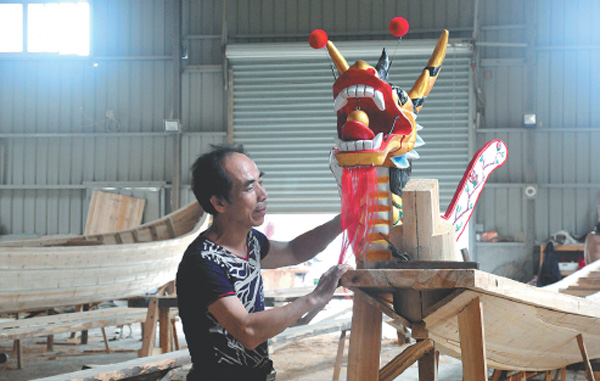 |
|
Fang Hegang works in his shipyard. He and his two brothers are famous for their advanced boat-making technique passed on from ancestors. [Photo/China Daily] |
Fang Hegang says he used to find workers at boat-making factories, but there are fewer and fewer. Fishermen often use steel boats because the government doesn't issue new permits to wooden boats to go fishing in the sea for safety concerns.
"It's the busy season and we have to work overtime. Like others, I love rowing dragon boats very much. Winning a contest brings me pleasure and pride," says Yi Hui, 40, the youngest worker in the dockyard.
Like many old craftsmen, Fang Hegang is worried about the passing on of the family traditions. He has decided to keep making boats until he's too old to do so. He persuaded his younger son to learn the craft, but is not sure whether he will stick to it.
"It's a laborious and seasonal job. Young people don't want to learn it; they have better job opportunities," he says.
"I know the philosophy but am not familiar with the practice. It takes at least three years to master all kinds of tools. My cousin has finished his apprenticeship and can carry on the business," says his elder son Fang Chuansheng, 30. He is a seaman and helps his father during busy seasons.
The son says the labor cost rises every year, but the prices of dragon boats remain much the same. After the festival, prices will be even lower. It's not as profitable as some other common industries.
The tradition of rowing dragon boats during the festival is not as popular as before, but their orders are rising in recent years. Fang Hegang recalls that the three brothers made about 50 boats a year, but in recent years the number is more than 100.
"In the past, people would ask us to repair their dragon boats and one boat might last for years. But nowadays with their increasing incomes, enthusiasts are willing to buy new boats," Fang Hegang says. The price of their dragon boat is about 20,000 to 30,000 yuan.
The most critical part of the dragon boats is the dragon head, which is like the soul of boats. People can change the heads as they like every year. The various dragon heads, together with the beautiful designs on the boat bodies, make a magnificent spectacle on the water.
About a few miles from the shipyard is Fang Xiaoshui's home. With the music of traditional Chinese opera playing, he and his two family members are busy painting colors to dragon heads carved out of camphorwood. About half of their business is building dragon heads, although they also make wood sculptures of Buddha.
"It's a tiring job and we have to deal with it very carefully. The business is becoming better because people are richer and like to have new dragon heads rather than use the old ones," says Fang Xiaoshui, 40, who started to learn the craft when he was a teen. Most dragon boat buyers from the city order dragon heads from him.
The family makes different shapes of colorful dragon heads in accordance with customers' demands. It takes about 30 days to finish one, with complicated procedures such as carving and polishing. The last step is to bring the dragon to life by painting the black pupils of its eyes.
He says they are auspicious symbols for villages and those with big mouth, large eyes and buckteeth are likely to draw attention during races. He also makes some uncommon ones such as a phoenix for female boat racers, lion, tiger and even panda.
SunLi contributed to the story.
